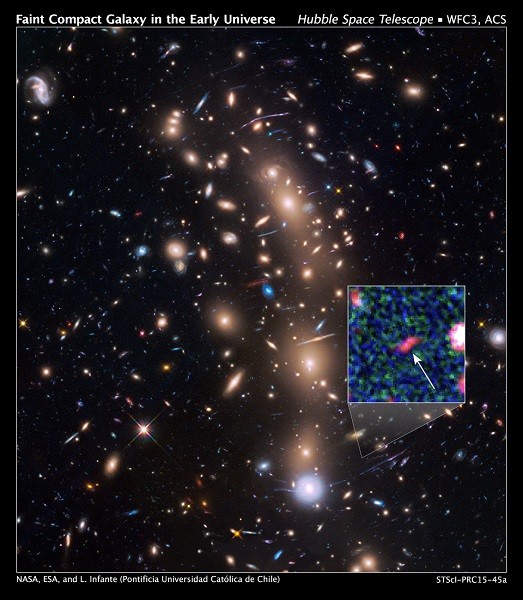NASA Space Telescopes Detect Faintest Galaxy in the Universe
| Ana Verayo | | Dec 04, 2015 06:41 AM EST |
(Photo : NASA, ESA, and L. Infante (Pontificia Universidad Católica de Chile)) This is a Hubble Space Telescope view of a very massive cluster of galaxies, MACS J0416.1-2403, located roughly 4 billion light-years away and weighing as much as a million billion suns. The cluster's immense gravitational field magnifies the image of galaxies far behind it, in a phenomenon called gravitational lensing.
Astronomers have discovered the faintest ever object yet in the universe with the help of NASA's Hubble Space Telescope and the Spitzer Space Telescope. This object is apparently a galaxy that existed some 13.8 billion years ago, some 400 million years after the Big Bang event.
Like Us on Facebook
This ancient galaxy is nicknamed as "Tayna", which means "first born" in the Aymara language spoken in the Andes region in South America, where this can shed light how the first galaxies in the universe came to be. This can also become an exciting target for the James Webb Space Telescope to uncover, as one of the ancient galaxies still existing from the early universe.
According to astronomer and lead author of the study, Leopoldo Infante from the Pontifical Catholic University of Chile, for the first time ever, the team was able to investigate the properties of these extremely faint cosmic objects that are formed after the Big bang.
Apparently this extremely distant galaxy is almost the same size as the Large Magellanic Cloud which is an extremely small satellite galaxy inside our Milky Way. However, Tayna is churning out new stars 10 times faster than the LMC where researchers believe that this will eventually evolve in to a full sized galaxy.
This galaxy is detected during the Frontier Fields program of the Hubble, which focuses on MACS J0416.1-2403, also regarded as a massive cluster of galaxies at a distance of roughly 4 billion light years away, with a stellar mass of more than 1 million suns. This colossal stellar cluster also serves as a powerful natural galactic lens that can bend and magnify light from even more distant objects behind the galaxy, that made this protogalaxy 20 times brighter than normal to be detected.
Scientists were able to calculate the distance of this new galaxy by using a composite color profile from images and data obtained from Hubble and Spitzer. As the universe expands, the light from these distant galaxies also appears to be stretched that increases the distance and the absorption of stellar material, hydrogen using infrared measurements.
This study is published in The Astrophysical Journal.
Tagsfaintest galaxy in the universe, early universe, faintest object in the universe, faintest galaxy, Big Bang, NASA, Hubble Space Telescope, spitzer space telescope, large magellanic cloud, gravitational lensing
©2015 Chinatopix All rights reserved. Do not reproduce without permission
EDITOR'S PICKS
-

Did the Trump administration just announce plans for a trade war with ‘hostile’ China and Russia?
-

US Senate passes Taiwan travel bill slammed by China
-

As Yan Sihong’s family grieves, here are other Chinese students who went missing abroad. Some have never been found
-

Beijing blasts Western critics who ‘smear China’ with the term sharp power
-

China Envoy Seeks to Defuse Tensions With U.S. as a Trade War Brews
-

Singapore's Deputy PM Provides Bitcoin Vote of Confidence Amid China's Blanket Bans
-

China warns investors over risks in overseas virtual currency trading
-

Chinese government most trustworthy: survey
-

Kashima Antlers On Course For Back-To-Back Titles
MOST POPULAR
LATEST NEWS
Zhou Yongkang: China's Former Security Chief Sentenced to Life in Prison

China's former Chief of the Ministry of Public Security, Zhou Yongkang, has been given a life sentence after he was found guilty of abusing his office, bribery and deliberately ... Full Article
TRENDING STORY

China Pork Prices Expected to Stabilize As The Supplies Recover

Elephone P9000 Smartphone is now on Sale on Amazon India

There's a Big Chance Cliffhangers Won't Still Be Resolved When Grey's Anatomy Season 13 Returns

Supreme Court Ruled on Samsung vs Apple Dispute for Patent Infringement

Microsoft Surface Pro 5 Rumors and Release Date: What is the Latest?










